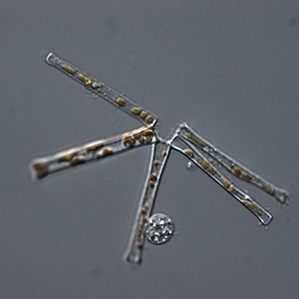Facts:
Mycoloop is a process where parasitic fungi render otherwise inedible phytoplankton edible to zooplankton grazers, by fragmentation or by producing zoospores.

Chytrids is a diverse group of fungi that sometimes act as parasites and infect aquatic microbes. Their role in aquatic ecosystems is believed to be important, but few studies have addressed their effect on e.g. algal blooms and phytoplankton succession.
Chytrids are early diverging zoosporic fungi from phylum Chytridiomycota. The recent discoveries of large diversities of novel chytrids has raised awareness on their important, but understudied, role in aquatic ecosystems. Parasitic chytrids drive important ecological processes e.g. suppressing phytoplankton blooms, altering phytoplankton succession, providing alternative energy pathways via the process called “mycoloop” (see fact box). Despite their essential role in planktonic carbon cycling very little is known about their biology and the molecular basis of the infection process remains a black box.
The aim of the MAP project, led by Dr. Silke Van den Wyngaert (WasserCluster Lunz), is to obtain the first genome assembly and meta-transcriptome sequences of obligate parasitic chytrids and their phytoplankton host to understand complex, molecular level, biological interactions between the two partners in a changing environment.
In a collaborative effort with Dr. Silke Van den Wyngaert (www.uglylab.eu) and Prof. Hans-Peter Grossart (IGB Berlin), FuME participants will perform the bioinformatic analysis of the generated genomic and transcriptomic sequences for these chytrids, their respective hosts and microbiome.
Funding from EASI-Genomics (2020-2021).
Mycoloop is a process where parasitic fungi render otherwise inedible phytoplankton edible to zooplankton grazers, by fragmentation or by producing zoospores.